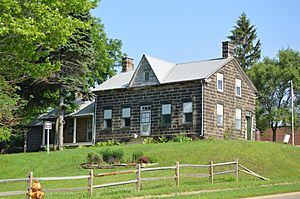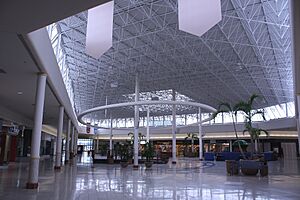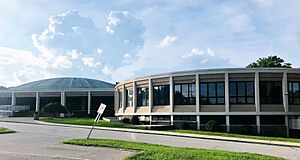Parma, Ohio facts for kids
Quick facts for kids
Parma, Ohio
|
|||
|---|---|---|---|
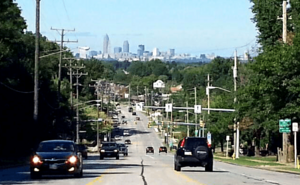
Cleveland's skyline from State Road
|
|||
|
|||
| Nickname(s):
The Garden City
|
|||
| Motto(s):
"Progress Through Partnerships"
|
|||
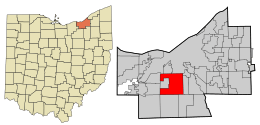
Location in Cuyahoga County, Ohio
|
|||
| Country | United States | ||
| State | Ohio | ||
| County | Cuyahoga | ||
| Founded | 1816 | ||
| Township | March 7, 1826 | ||
| Incorporated | December 15, 1924 (village) & January 1, 1931 (city) | ||
| Named for | Parma, Italy Parma translated refers to a round shield, such as the one used by Roman legionaries |
||
| Government | |||
| • Type | Mayor–council | ||
| Area | |||
| • City | 20.07 sq mi (51.98 km2) | ||
| • Land | 20.02 sq mi (51.86 km2) | ||
| • Water | 0.05 sq mi (0.12 km2) | ||
| Elevation | 863 ft (263 m) | ||
| Population
(2020)
|
|||
| • City | 81,146 | ||
| • Density | 4,052.64/sq mi (1,564.74/km2) | ||
| • Metro | 2,064,725 (US: 29th) | ||
| Demonym(s) | Parmesan, Parmanian | ||
| Time zone | UTC-5 (EST) | ||
| • Summer (DST) | UTC-4 (EDT) | ||
| ZIP Code |
44129, 44130, 44134
|
||
| Area code(s) | 440 & 216 | ||
| FIPS code | 39-61000 | ||
| GNIS feature ID | 1049063 | ||
Parma is a city in Cuyahoga County, Ohio, United States. It is a suburb located just south of Cleveland. In 2020, about 81,146 people lived there. Parma is the seventh-largest city in Ohio by population. It is also the biggest suburb in the state and the second-largest city in Cuyahoga County.
Contents
History of Parma
Early Days: Greenbriar (1806–1826)
The area that is now Parma was first surveyed in 1806. It was known as Township 6 - Range 13. People also called it "Greenbriar" because of the many green plants growing there.
The first settlers arrived in 1816. They were Benajah Fay, his wife Ruth, and their ten children. They came from New York. At this time, Greenbriar started to manage its own local government.
Becoming Parma Township (1826–1924)
When about twenty families lived in Greenbriar, they wanted more self-government. Before forming a new township, the name Greenbriar was changed to Parma. This happened because Dr. David Long had visited Parma, Italy. He was so impressed by its beauty that he convinced the settlers to use the name Parma.
So, on March 7, 1826, a new township was officially created and named Parma. The first local leaders were elected on April 3, 1826.
For a long time, Parma Township was mostly farmland. The first school was a log cabin on a hill where the Parma Heights Cemetery is now. In 1827, the township divided its roads into districts. Some of today's main roads, like Broadview Road and Pearl Road, had different names back then.
The Henninger House, a stone house built in 1849, is still standing today. It was home to many generations of the Henninger family. This house is on one of the highest points in Cuyahoga County. Long ago, Erie Indians used this spot to send smoke signals and pray.
By 1850, Parma Township had 1,329 people. The American Civil War affected Parma, with many families sending members to fight. By 1910, the population grew to 1,631.
In 1911, Parma Heights separated from Parma Township. This happened because people in Parma Heights wanted to control alcohol sales. They voted to become their own village to get a town marshal.
Parma as a Village (1924–1930)
In 1920, Parma Township had 2,345 people. The next ten years brought a lot of growth. Parma changed from a farming area into a village. On December 15, 1924, Parma officially became a village.
One of the biggest new developments was Ridgewood Gardens, started in 1919. It was planned as a "model village" with churches, schools, and a community center. It was designed to be a "Garden City" for about 40,000 people. The idea was to create a healthy place away from city smoke and noise.
Parma Becomes a City (1931–present)
On January 1, 1931, Parma became a city with 13,899 residents. However, the Great Depression slowed down its growth. Money was tight, and some people even suggested Parma should join Cleveland. But Parma voters strongly said no to this idea.
After World War II, Parma grew very quickly. Many young families moved from Cleveland to the suburbs. Between 1950 and 1960, Parma's population jumped from 28,897 to 82,845. By 1956, Parma was one of the fastest-growing cities in the United States. Its population reached its highest point in 1970 with 100,216 people.
In 2016, Parma's population was 81,601. It is still a popular place for young adults (ages 22 to 34) to live. In 2016, Businessweek magazine called Parma one of the best places in Ohio to raise kids.
Geography of Parma
Parma is located southwest of Cleveland. It shares borders with several other cities. To the north are Cleveland and Brooklyn. To the east are Brooklyn Heights and Seven Hills. To the south are North Royalton and Broadview Heights. To the west are Brook Park, Middleburg Heights, and Parma Heights.
The city covers about 20.07 square miles (51.98 square kilometers). Most of this area is land, with a small amount of water.
Recently, two important sites in Parma have seen changes:
- The West Creek Preservation Agency works to protect historic and natural places. This includes the Henninger House and the West Creek Watershed.
- The Henninger House, built in 1849, is Parma's oldest standing home. It is planned to be part of the new Quarry Creek Historic District.
Parma's Population and People
| Historical population | |||
|---|---|---|---|
| Census | Pop. | %± | |
| 1930 | 13,899 | — | |
| 1940 | 16,365 | 17.7% | |
| 1950 | 28,897 | 76.6% | |
| 1960 | 82,845 | 186.7% | |
| 1970 | 100,216 | 21.0% | |
| 1980 | 92,548 | −7.7% | |
| 1990 | 87,876 | −5.0% | |
| 2000 | 85,655 | −2.5% | |
| 2010 | 81,601 | −4.7% | |
| 2020 | 81,146 | −0.6% | |
| U.S. Decennial Census | |||
In 2013, Parma became a "sister city" with Lviv, Ukraine. This means they have a special friendship and cultural exchange. Parma has Ohio's largest Ukrainian community. Most of these residents were born outside the U.S.
Parma is also home to the center of the Ukrainian Catholic Eparchy of Saint Josaphat in Parma. This religious center was created by Pope John Paul II in 1983.
Population in 2020
The 2020 United States census showed that Parma had 81,146 people.
- About 82.3% were White (not Hispanic).
- About 6.8% were Hispanic/Latino.
- About 4.0% were Black (not Hispanic).
- About 2.5% were Asian.
- About 4.4% were from mixed or other backgrounds.
| Race / Ethnicity (NH = Non-Hispanic) | Pop 2000 | Pop 2010 | Pop 2020 | % 2000 | % 2010 | % 2020 |
|---|---|---|---|---|---|---|
| White alone (NH) | 81,102 | 74,186 | 66,785 | 94.68% | 90.91% | 82.30% |
| Black or African American alone (NH) | 901 | 1,797 | 3,271 | 1.05% | 2.20% | 4.03% |
| Native American or Alaska Native alone (NH) | 110 | 121 | 140 | 0.13% | 0.15% | 0.17% |
| Asian alone (NH) | 1,346 | 1,497 | 2,027 | 1.57% | 1.83% | 2.50% |
| Pacific Islander alone (NH) | 13 | 11 | 8 | 0.02% | 0.01% | 0.01% |
| Some Other Race alone (NH) | 50 | 54 | 257 | 0.06% | 0.07% | 0.32% |
| Mixed Race or Multi-Racial (NH) | 810 | 1,020 | 3,094 | 0.95% | 1.25% | 3.81% |
| Hispanic or Latino (any race) | 1,323 | 2,915 | 5,564 | 1.54% | 3.57% | 6.86% |
| Total | 85,655 | 81,601 | 81,146 | 100.00% | 100.00% | 100.00% |
Population in 2010
In 2010, Parma had 81,601 people living in 34,489 households. The city's population density was about 4,076 people per square mile.
Many people in Parma have European backgrounds. The largest groups include:
Most people in Parma speak English at home (87.03%). Other languages spoken include Ukrainian, Polish, Spanish, German, and Italian.
The average age in Parma was 41.5 years. About 20.4% of residents were under 18.
Income and Safety
The average income for a household in Parma was about $50,198. For families, it was about $60,696. The average income per person was $25,064. Parma has a low poverty rate of 10.2%, which is lower than the average for Ohio cities.
Economy in Parma
As Parma's population grew, so did its businesses. Since the 1950s, Parma has supported many small businesses. It has also been a base for larger companies like General Motors and Cox Cable.
The Shoppes at Parma, once called Parmatown Mall, is a large shopping area. It covers about 800,000 square feet. You can find stores like JCPenney, Dick's Sporting Goods, Marc's, and Walmart there. The mall first opened as a shopping plaza in 1956.
Parma also has special commercial areas:
- The Ukrainian Village is along State Road. It was named in 2009 and hosts the Ukrainian Independence Day parade in August.
- The Polish Village is along Ridge Road. It was named in 2011. This area has many small, family-owned businesses. It hosts parades for Polish Constitution Day (May), St. Charles Carnival (July), Independence Day (July), and Christmas (December).
Education in Parma
The Parma City School District serves students in Parma, Parma Heights, and Seven Hills. The district has a sports stadium called Byers Field. All three high schools use Ridgewood for their home golf course.
The school district has:
- Six elementary schools
- Three middle schools
- Two high schools: Normandy High School and Valley Forge High School. The former Parma Senior High School closed in 2023.
There are also public charter schools called Constellation Schools: Parma Community. They include two elementary schools, one middle school, and one high school.
Parma has eight private elementary schools and a private high school called Padua Franciscan High School.
For higher education, Bryant & Stratton College and Cuyahoga Community College both have campuses in Parma.
Transportation in Parma
Parma has several main roads that help people get around.
Major roads running north to south (from west to east):
- West 130th Street (part of Parma's western border)
- Chevrolet Boulevard/Stumph Road/York Road
- Ridge Road (State Route 3)
- West 54th Street
- State Road (State Route 94)
- Broadview Road (State Route 176), which connects to downtown Cleveland via the Jennings Freeway.
Major roads running east to west (from north to south):
- I-480 (just north of Parma's border)
- Brookpark Road (State Route 17), which forms Parma's northern border with Cleveland
- Snow Road
- West Ridgewood Drive
- West Pleasant Valley Road
- Sprague Road (Parma's southern border)
Also, Pearl Road (U.S. Route 42) cuts through northern Parma for a short distance.
The speed limit on most main roads in Parma is 35 miles per hour. In business areas, it is 25 miles per hour.
Public transportation in Parma includes bus routes. These are run by the Greater Cleveland Regional Transit Authority. They serve Cleveland and its nearby suburbs in Cuyahoga County.
Notable people from Parma
Many interesting people have connections to Parma:
- Bill Balas, a screenwriter, director, and producer
- Michael Bierut, a graphic designer
- Hector Boiardi, known as Chef Boyardee, who died in Parma
- Carmen Cozza, a football coach at Yale University
- Timothy DeGeeter, a state representative
- Dan Fritsche, an NHL hockey player
- Michael T. Good, a NASA astronaut
- Brian Holzinger, an NHL hockey player
- James Hoye, an umpire in Major League Baseball
- Scott Jarvis, an actor
- William Kowalski, an author and educator
- Ted Levine, an actor
- James A. Lovell, a NASA astronaut who flew on Gemini 7, Gemini 12, Apollo 8, and Apollo 13 missions
- Biagio Messina, a television producer, filmmaker, and actor
- Mike Mizanin, an actor and professional wrestler known as The Miz
- Alex Nedeljkovic, a goaltender for the Pittsburgh Penguins of the NHL
- Ransom E. Olds, a pioneer in the automotive industry
- Benjamin Orr, co-lead singer and bassist for the band The Cars
- Kermit Poling, a conductor, violinist, and composer
- Frank Romano, a guitarist, songwriter, and record producer
- Alan Ruck, an actor known for Ferris Bueller's Day Off
Images for kids
See also
 In Spanish: Parma (Ohio) para niños
In Spanish: Parma (Ohio) para niños






